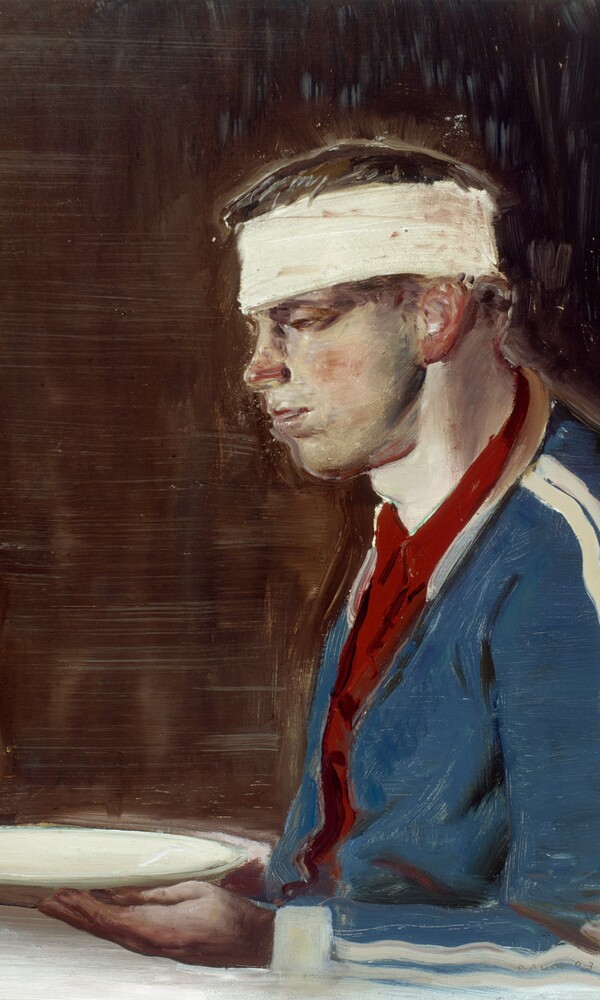Im Mittelpunkt der Ausstellung Müde Helden: Ferdinand Hodler - Aleksandr Dejneka - Neo Rauch steht die Entwicklung der Utopie des 'Neuen Menschen' im 20. Jahrhundert. Am Anfang dieser historischen Entwicklung steht der Schweizer Maler Ferdinand Hodler. Als einer der künstlerischen Exponenten der Lebensreformbewegung gibt er dem um 1900 mit großem Pathos vorgetragenen Thema des 'Neuen Menschen' in seiner Malerei künstleriscThe exhibition Müde Helden (Exhausted Heroes). Ferdinand Hodler – Aleksandr Dejneka – Neo Rauch deals with the utopian ideal of the ‘Neue Mensch’ (‘new man’) and its history in the 20th century. In the oeuvre of the three painters featured in this exhibition, the radical transformation of this ideal can be observed in exemplary fashion. It starts with the proclamation of the ‘new man’ at the beginning of the 20th century, leads on to the political appropriation of the ideal in the vision of a socialist order, and ultimately draws to a close with the abandonment of all idealism after the end of Communist rule in the East Bloc in the late 1980s.
The art of the Swiss painter Ferdinand Hodler (1853–1918) is deeply rooted in the ideals of the ‘life reform’ movement. The discourses of a ‘new man’ that featured so prominently, and with great pathos, in the Lebensreform movement naturally found their way into his paintings. Despite their monumental appearance, his large-scale renditions of both female and male figures are marked by a measure of decoration and affectation. To the degree that Hodler subdued the heroism of his figures, they are here presented as tired, or ‘exhausted heroes’.
Kursk-born painter Aleksandr Dejneka (1899-1969), was a leading representative of post-revolutionary painting in Russia between 1918, the year of Hodler’s death, and 1932, when Socialist Realism was proclaimed as the official art of the Soviet Union. In his subject matter, in the painterly modeling of his figures, and in their gestures and posture, Dejneka closely appropriates the model of Hodler’s figural compositions and relocates them in a post-revolutionary Russian context – a process that has hitherto gone unnoticed. In this way, for instance, Dejneka transforms Hodler’s blossoming nature into an industrial landscape under construction. His working women and men appear like a renewal of the Swiss painter’s symbolist works in proletarian guise.
After the fall of the Berlin wall in 1989, the painter Neo Rauch (*1960), who grew up and was educated in East-Germany, takes up exactly the type of figure developed by Hodler and Dejneka. In conscious reference to the heroes of technology and industry from the ‘Twenties and ‘Thirties, Rauch’s figures are frozen in meaningless postures, performing inhibited actions and quixotic rituals in late industrial settings. The utopian vision of a ‘new man’ is here turned into a complete denial of any faith in progress or ideology of any kind.
In the exhibition Müde Helden the oeuvre of Neo Rauch, the internationally renowned representative of the ‘Leipzig School’ of painting, is for the first time presented in a historical and an art-historical perspective. Moreover, the exhibition offers a singular opportunity to discover the oeuvre of Aleksandr Dejneka, a painter very highly-esteemed in Russia, who is represented by a large number of important works that have never before been shown in Germany. In thematically ordered references to the large number of works by their modern predecessor, Ferdinand Hodler, the exhibition presents a historical development from the ‘New Man’ around 1900 to the contemporary figure of a ‘Tired Hero’.
The exhibition comprises more than ninety artworks, mostly large-scale paintings.hen Ausdruck. Seine großfigurigen Gemälde weiblicher und männlicher Gestalten tragen jedoch ungeachtet ihrer monumentalen Gestalt bereits die Zeichen des Artifiziellen und Dekorativen an sich - und können von daher als 'müde Helden' betrachtet werden. Der im Westen weniger bekannte, 1899 in Kursk geborene russische Maler Aleksandr Dejneka war zwischen 1918, dem Todesjahr Ferdinand Hodlers und der Verordnung des Sozialistischen Realismus in der Sowjetunion im Jahr 1932 ein Protagonist der postrevolutionären Malerei. Bisher völlig unbeachtet blieb, wie sehr sich Dejneka in seinen Bildmotiven, wie auch in der Körpersprache und der Modellierung seiner Personen an Hodlers eurythmisch bewegten Figuren orientiert. In seinen Gemälden ersetzt Dejneka die aufblühende Natur durch im Aufbau befindliche Industrielandschaften. Dejnekas Arbeiterinnen und Arbeiter erscheinen wie die Wiedergeburt der symbolistischen Malerei des Schweizers in proletarischem Gewand. Im letzten Jahrzehnt des 20. Jahrhunderts greift der in der DDR aufgewachsene und ausgebildete Neo Rauch den von Hodler und Dejneka geprägten Typus nach dem Ende des Kommunismus erneut auf. Mit bewusstem Rückgriff auf die Helden aus der Technik und Industrie der 1920er und 1930er Jahre lässt er die Figuren in Posen der Handlungshemmung erstarren und in absurden Zusammenhängen ins Leere laufen. Die Utopie des 'Neuen Menschen' verkehrt sich hier in eine Absage an die Fortschrittsgläubigkeit und an jegliche Ideologie. In der Ausstellung Müde Helden wird das Werk des international anerkannten, führenden Malerstars der Leipziger Schule, Neo Rauch, erstmals in einen historischen und kunsthistorischen Zusammenhang präsentiert. Zudem bietet Müde Helden die Gelegenheit das Werk des in Russland hoch verehrten Malers Aleksandr Dejneka zu entdecken, der mit einer großen Anzahl wichtiger Gemälde vertreten sein wird, die noch nie in Deutschland zu sehen waren. Die Ausstellung umfasst etwa 80 großformatige Gemälde sowie Graphik und Zeichnungen und wird in der ersten und zweiten Etage der Galerie der Gegenwart zu sehen sein.
